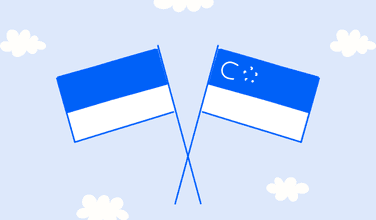- Osome Blog SG
- Trade Mark Registration in Singapore
Trade Mark Registration in Singapore
- Modified: 26 December 2024
- 8 min read
- Incorporation


Anastasia Sikorskaya
Author
Anastasia Sikorskaya is an editor and a legal specialist. She studied in Moscow and Berlin and worked for an international company as a lawyer. Anastasia enjoys explaining the law in human language.
Now let's take a look at the trade mark registration procedure itself. Here is a step-by-step guide that will help you protect your trade mark in Singapore and worldwide.
Before you take a look at the steps, maybe consider hitting us up? If you need your company incorporated, we would be glad to help you register your trade mark as well!
What Is a Trade Mark?
Trade mark is a sign that distinguishes a business's goods or services from those of others. This sign can be a word, logo, phrase, or a combination of elements. For a trade mark to be protected, it must be registered with the Intellectual Property Office of Singapore (IPOS), giving the owner exclusive rights to use it. Registration lasts ten years and can be renewed indefinitely. Trade marks must be distinctive, non-deceptive, and not too similar to existing trade marks. Unauthorised use of a registered trade mark is considered infringement, allowing the owner to take legal action. Singapore's participation in the Madrid Protocol enables businesses to seek international protection through a single trade mark application.
The registration and protection of trade marks in Singapore are governed by the Trade Marks Act. This legislation outlines the legal framework for trade mark registration, rights, and enforcement, ensuring that trademarks are properly protected and managed within the jurisdiction. Trade mark law in Singapore ensures that the legal processes and protections are in place for the effective management and enforcement of trade mark rights.
Trade Mark Registration Process
The trade mark registration process in Singapore is a well-defined procedure that ensures your mark is protected under the law. Navigating this process effectively is crucial for securing your brand's identity and legal rights. To register a trade mark, applicants must carefully follow the outlined steps. Below, you'll find a detailed overview of the key steps involved in registering a trade mark, from the initial application to securing exclusive protection.
Step 1. Create a trade mark
First of all, you need to develop a graphical representation of a trade mark. You can either draw or type it yourself in any image editing program or hire a designer for more complicated work. The image should be big enough to ensure that all details are clearly shown, but not larger than A4 paper size.
If your trade mark contains important details, make sure to denote them in your application. For example, provide an image in colour if you want to register it in specific colours. If a trade mark has a complex shape, present multiple views of the 3d object. If it is not only the shape that is important, but its position on an object, as well, show it to the registrar. For instance, a label and a fancy stitch line on jeans pockets. If you register a sound mark, you are going to need not only a musical notation but also an audio file.
Make sure to check your trade mark for all the registration criteria. Otherwise, an application might be rejected.
Since 15 April 2019, there is no obligation to provide translation and transliteration for non-English words or characters appearing in a trade mark. So, you only type original words and characters in an application in the text format and the system will automatically generate the translation and transliteration.
Step 2. Decide what products you are registering a trade mark for
Once you come up with the graphical visualisation of your trade mark, you need to decide what goods and services you want it to be registered as. Looking for the appropriate class of goods and services for your brand may depend on the trademark laws of the country where you intend to register your trade mark. There are 45 different classes listed in the international classification accepted by various countries . the Nice Classification of Goods and Services. In the application, you state the class numbers and cite specific goods and services you are interested in. You can pick more than one class.
To decide what class your trade mark fits in, see IPOS Class Headings. Remember that these are only headings for easy reference.
Step 3. Do your research
Before applying, make sure no one has registered a trade mark resembling yours before. The registration fee is non-refundable, so if a similar or identical trade mark already belongs to some other company operating in the same industry, the applicant will lose not only the time spent on the application, but also the money.
Keep in mind that an existing identical or similar trade mark used in a different industry might pose no threat to you. Legally, if there is already an “Ouroboros” trade mark used for ice cream and you want to register “Ouroboros” to produce machinery with an absolutely different graphical representation, you are good to go. The final word belongs to IPOS though, and it will make sure that both brands are clearly distinguishable.
To search through existing trade marks, you can use the e-service IP²SG.
Step 4. File the application
You may submit a trade mark application online or on paper. For fully electronic registration, use IP²SG. If you prefer paper documents, you can send an application via post or submit it personally at the Intellectual Property Office of Singapore. Keep in mind that online forms are processed quicker and are cheaper to file.
Things to submit when applying for trade mark registration:
- your company data or your personal information if you file an application as an individual;
- clear graphical representation of a trade mark;
- description of the device used with the trade mark or description of the non-conventional trade mark if that is the case. E.g. if your company produces smartphones, mention in the application that you will put your trade mark on the back of your smartphones. If you register a sound mark or a hologram, you need to describe it as well;
- goods and services for which the trade mark is to be registered;
- declaration to use the trade mark in good faith.
If you register a trade mark for more than one class, you can submit either one general application for all classes or separate applications for each class. The number of applications doesn’t affect the fee as you pay for every class anyway. A multi-class application makes it easier to manage the registration and helps to avoid piles of documents for the same trademark. On the other hand, if the authorities raise an objection to a multi-class application, it will delay the registration of the trade mark for all of the classes. If an applicant fails to respond to IPOS’s notes and misses the deadline, the entire application gets rejected. Thus, if you suspect that there might be some problems with some of the chosen classes, we suggest filing several applications.
Check the application carefully. After you submit it, you can only make minor changes. like changing the name or the address of the applicant or the agent’s data, for free.
Form TM27 for amendments to the application
User manuals for IP²SG (scroll down to “TM4. Application to Register a Trade Mark, Collective Mark or Certification Mark”)
Step 5. Pay the fee
The payments are made via IP²SG. You will receive payment instructions in three business days after you submit the application. The fee depends on the class of goods and services you are registering your trade mark for. If you picked several classes, you will have to pay for each.
Fees for online filing:
- S$240.00 if you choose goods and services from a pre-approved database;
- S$341.00 if you don’t use the pre-approved database and indicate your own specification for goods and services.
Fee for manual filing S$374.00.
Fee for amendments to the application as directed by the examiner S$40.00.
All fees in regard to trade marks
Step 6. Obtain a trade mark number and pass the examination
Once your application is filed and the fee is paid, the Intellectual Property Office of Singapore assigns a unique trade mark number to your application. This number is used to track the status and details of your trade mark throughout the registration process and during its period of protection. The date on which you file your application becomes the filing date, which is important for establishing the priority of your trademark.
IPOS then examines the trade mark for compliance with legal requirements. Is the trade mark deceptive? Is it non-descriptive? Is it contrary to public interests? Is there a trade mark like yours that is already registered? Has anyone applied for the registration of a similar or identical trade mark before you? The examiner also checks that goods and services mentioned in the application correspond to the Nice Classification.
If something is wrong, the Intellectual Property Office of Singapore (IPOS) will inform the applicant and establish a timeframe for responding to the problem. If the applicant fails to answer before the deadline, the application is going to be rejected. There is a possibility to extend the deadline if necessary.
Step 7. See your trade mark published and wait for the comments
If no objection has been raised or if all objections have been resolved, IPOS publishes the application in the Trade Marks Journal. Over the next two months, every interested party may oppose the trade mark registration by filing a notice of opposition. The applicant must respond with a counter-statement. The fee is S$374.00 per class for online opposition and S$360.00 per class for online counter-statement.
Example
Green Eco Food Pte. Ltd. files an application for registering a designer shape of a lunch box in green for kitchenware. Two months later BeautyCo Pte. Ltd. files an application for the same shape in yellow for cosmetic products. Green Eco Food Pte. Ltd. files a notice of opposition because the trade mark of BeautyCo Pte. Ltd. is similar to the pending one. BeautyCo Pte. Ltd. needs to file a counter-statement. The registrar will hear the case based on evidence provided by both parties and will make a decision.
Step 8. Get your registration
After all issues are resolved, IPOS registers the trade mark and issues a certificate. The registration date is the date when you submitted the application.
A trade mark is protected for 10 years. After that you need to follow the renewal procedure. The fee depends on when the application for renewal is filed. It is best to apply no later than 6 months ahead of the expiry date. If you apply later, the costs increase from S$380.00 to S$610.00 per class for online filing.
What Is a Priority Claim?
If you have applied for registration of the same trade mark in another country within the last six months, you may have an advantage over other applicants in Singapore. In case someone tries to register the same trade mark after the date when your application was first filed in another country, you have a priority right. The country of original registration must be a member of the Paris Convention or the World Trade Organization. If you want to claim priority, you must indicate it in a corresponding section of the application form.
How To Protect a Trademark Worldwide?
To register a trade mark and obtain protection outside Singapore, you may file an additional application with the IPOS instead of applying in every relevant country separately. The consolidated international protection is valid only in the countries which are members of the Madrid Protocol. The condition is that a trade mark must first be registered or applied for in the country of origin. So, you must:
- have an application or a registration of a trade mark for the same goods and services in Singapore;
- be a national or a resident of Singapore or have a real and effective business here.
Two fees apply for international trade mark registration. The administrative fee of IPOS is S$250. The WIPO fee varies depending on the type and the colour of a trade mark and the number of classes it is being registered for.
After the registration process, a trade mark will appear in the international register and will be protected worldwide for 10 years with the possibility of renewal. For the first five years, the international registration depends on the validity of the registration in the country of origin. That means that if the registration is cancelled or revoked in Singapore, international registration will also be withdrawn.
Key Takeaways
- Properly prepare for registration and conduct preliminary research, it will save you time and money.
- Communicate with IPOS online via e-service IP²SG, it is quicker and cheaper.
- Stay alert even after your application is submitted as there might be objections against your trade mark being registered to which you will need to respond.
- Apply for international protection of your trade mark after registering it locally. File a single application to IPOS instead of registering a trade mark in every country separately.






